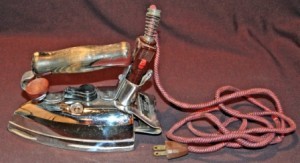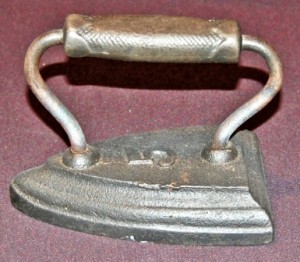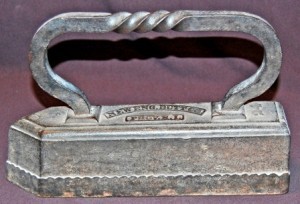By Kylin Cummings
The drudgery of ironing was a laborious task that once consumed entire days of homemakers. In the 1950s, a synthetic wrinkle-free fabric called polyester was introduced, saving countless hours for these overworked and underappreciated defenders of the domestic realm.
 It took literally thousands of years for this great leap forward to happen. Starting in the 1st century BC, the Chinese used metal pans filled with hot coals or sand. They were able to remove wrinkles in their clothing by moving the pan across them. During the Middle Ages, people used stones, glass and wood for smoothing fabrics. Flattish hand-size stones were rubbed over woven cloth to smooth it, polish it, or to press in pleated folds.
It took literally thousands of years for this great leap forward to happen. Starting in the 1st century BC, the Chinese used metal pans filled with hot coals or sand. They were able to remove wrinkles in their clothing by moving the pan across them. During the Middle Ages, people used stones, glass and wood for smoothing fabrics. Flattish hand-size stones were rubbed over woven cloth to smooth it, polish it, or to press in pleated folds.
In approximately the 15th century, the box iron was invented. It was composed of a flat-bottom box and a handle. Hot coals, bricks, slugs (heated metal inserts) or some other heating elements were heated and placed inside. Brick inserts could be used for a longer-lasting, less-intense heat.
What present-day consumers would recognize as an iron first appeared in Europe by the 1300s. The flatiron was comprised of a flat piece of iron with a metal handle attached. The iron would be heated over flames until sufficiently hot, at which time it would be picked up with an insulated glove or a padded holder. A layer of cloth would cover the clothing to prevent soot from staining the finished garment.
 A sadiron is an alternative name for a flat iron and is often used to distinguish the largest and heaviest of flat irons, usually five to nine pounds. A master tailor would employ an extremely heavy sadiron, weighing 16 to 18 pounds, known as the tailor’s goose. The iron was used until it was too cool to do its job. Many people owned several irons so they could heat one or more on the fire while one was being used.
A sadiron is an alternative name for a flat iron and is often used to distinguish the largest and heaviest of flat irons, usually five to nine pounds. A master tailor would employ an extremely heavy sadiron, weighing 16 to 18 pounds, known as the tailor’s goose. The iron was used until it was too cool to do its job. Many people owned several irons so they could heat one or more on the fire while one was being used.
With the invention of cast iron during the 19th century, the irons could now be heated on the cast iron stoves, which were cleaner and easier than fire. Even with heating on the stovetop, the irons would sometimes heat unevenly and the handle also would heat up, which posed problems for users.
Mary Florence Potts solved these predicaments in 1870. She made a plaster of Paris covering that was placed around the iron's body, which kept it cooler for more even heating. Potts also devised a detachable wooden handle that was spring loaded. Because wood does not hold heat in the same way iron does, people were less likely to be burned. Additionally, this sadiron was designed to come to a point at both ends, which allowed women to iron in either direction. Mrs. Potts’ Sadirons were sold in sets of three irons and one handle, the idea being that two irons could be heating on the stove while one was in use. When that iron cooled, another was ready to go.
 In the 1870s, inventors created a much lighter iron that was heated using gas or alcohol fuel. One type plugged directly into a natural gas line and other types stored fuel in a tank at the back of the iron. When the burner was lit with a match, the iron heated up. The iron was very hot and gas sometimes leaked, which smelled bad. The irons also often exploded or caught on fire when lit, burning the handle and, sometimes, the user.
In the 1870s, inventors created a much lighter iron that was heated using gas or alcohol fuel. One type plugged directly into a natural gas line and other types stored fuel in a tank at the back of the iron. When the burner was lit with a match, the iron heated up. The iron was very hot and gas sometimes leaked, which smelled bad. The irons also often exploded or caught on fire when lit, burning the handle and, sometimes, the user.
The invention of the electric iron coincided with the widespread electrification of American homes in the 1880s. The first electric iron was heated on a stand that was hooked up to an electrical source by detachable wires. One big problem was that it heated very slowly on the stand, and cooled quickly while in use.
In 1903, irons were being produced with electric cords directly attached to the iron. This development helped  solve the centuries-old necessity of constantly reheating the iron. In the 1920s, automatic heat controls made of pure silver were added to irons. Very quickly, many irons came equipped with these thermostats to control the level of heat.
solve the centuries-old necessity of constantly reheating the iron. In the 1920s, automatic heat controls made of pure silver were added to irons. Very quickly, many irons came equipped with these thermostats to control the level of heat.
The development of an aluminum sole plate in 1938 ended the centuries old problem of rusting. The first iron with automatic shut off was introduced in 1984, and by 1995 most sole plates had a nonstick coating.
The Sharlot Hall Museum has 40 different irons including some specialty types not mentioned in this article. Come see a selection of these irons in the temporary exhibit case in the Lawler Center foyer.
“Days Past” is a collaborative project of the Sharlot Hall Museum and the Prescott Corral of Westerners International (www.prescottcorral.org). This and other Days Past articles are also available at www.sharlothallmuseum.org/library-archives/days-past. The public is encouraged to submit proposed articles to dayspastshmcourier@gmail.com. Please contact SHM Library & Archives reference desk at 928-277-2003, or via email at dayspastshmcourier@gmail.com for information.


